Anastomus is a genus of birds belonging to the family Anatidae, commonly known as the openbills.
These distinctive birds are characterized by their unique bill structure, which features a gap or notch near the tip, allowing them to efficiently feed on mollusks, particularly snails and other aquatic invertebrates.
The genus includes two species: the Asian openbill (Anastomus oscitans) found in South and Southeast Asia and the African openbill (Anastomus lamelligerus) native to sub-Saharan Africa.
Anastomus birds are typically found in wetland habitats such as marshes, swamps, and flooded plains, where they forage for their preferred prey.
Despite their relatively small size compared to other waterfowl, Anastomus species play a significant ecological role in maintaining the balance of their respective ecosystems through their feeding habits and interactions with other organisms.
How to Identify Anastomus?

Identifying Anastomus birds, commonly known as openbills, requires attention to several distinctive features and behaviors. Here are eight key points to help you distinguish these unique avian species:
Bill Structure
The most conspicuous feature of Anastomus birds is their bill. Unlike most other waterfowl, Anastomus species possess bills with a distinctive gap or notch near the tip.
This characteristic gives the bill a distinctively “open” appearance, hence the common name “openbill.” The bill is also relatively long and slender, suited for probing into crevices to extract prey.
Coloration
Both species within the genus Anastomus exhibit similar coloration patterns. The plumage of adult birds is predominantly dark, often appearing black or dark brown.
However, upon closer inspection, you may notice subtle variations in shading, with some individuals exhibiting iridescent or glossy hues under certain lighting conditions.
Size and Shape
Anastomus birds are medium-sized waterfowl with a body length typically ranging from 60 to 75 centimeters (24 to 30 inches).
They have a relatively long neck and legs compared to their body size, giving them an elegant and elongated appearance, particularly when wading in shallow water.
Flight Pattern
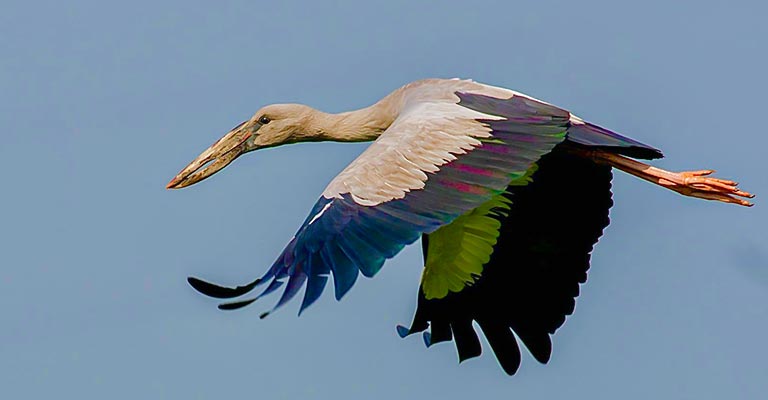
When in flight, Anastomus birds display a distinctive silhouette characterized by their long, slender wings and extended necks.
Their flight is often buoyant and graceful, with steady wingbeats punctuated by occasional glides. The distinctive notch in their bill may also be visible during flight, further aiding in identification.
Habitat Preference
Anastomus species are primarily associated with wetland habitats such as marshes, swamps, and flooded plains.
They are often found foraging along the edges of water bodies or in shallow, muddy areas where their preferred prey, including snails and other aquatic invertebrates, are abundant.
Behavioral Traits
One notable behavior of Anastomus birds is their methodical foraging technique. They can often be observed wading slowly through shallow water, using their specialized bill to probe mud and vegetation for food.
Their feeding behavior is typically deliberate and precise, with occasional pauses to swallow captured prey.
Vocalizations
While not particularly vocal compared to other bird species, Anastomus birds may emit soft, low-pitched calls or croaks during social interactions or while in flight.
These vocalizations can vary in intensity and frequency depending on the context, but they are generally not as prominent as those of other waterfowl species.
Range and Distribution
The two species within the genus Anastomus, namely the Asian openbill (Anastomus oscitans) and the African openbill (Anastomus lamelligerus), have distinct but overlapping ranges.
The Asian openbill is found in South and Southeast Asia, while the African openbill inhabits sub-Saharan Africa. Understanding the geographic distribution of each species can aid in identifying them in the wild.
Observing these key characteristics, observers can confidently identify Anastomus birds and appreciate their unique adaptations for life in wetland environments.
Taxonomy of Anastomus
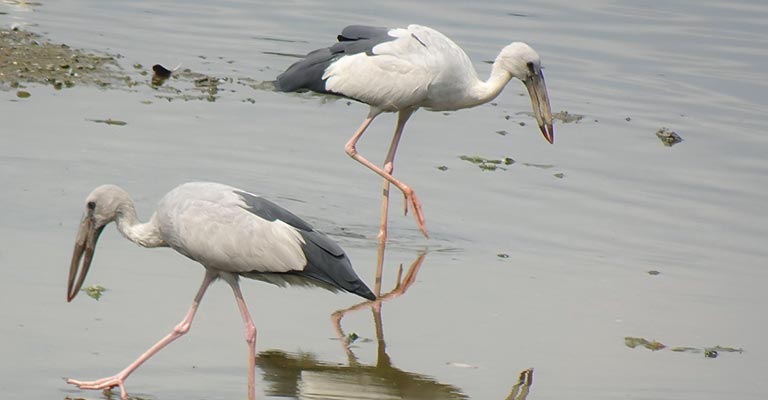
Here’s a table detailing the taxonomy of the Anastomus:
| Domain | Eukaryota |
| Kingdom | Animalia |
| Phylum | Chordata |
| Class | Aves |
| Clade | Aequornithes |
| Order | Ciconiiformes (Bonaparte, 1854) |
| Family | Ciconiidae |
| Genus | Anastomus |
| Species | Ardea oscitans |
The species A. lamelligerus and A. oscitans belong to the genus Anastomus and are collectively known as openbills. Here’s an overview of each species:
A. lamelligerus (African Openbill)
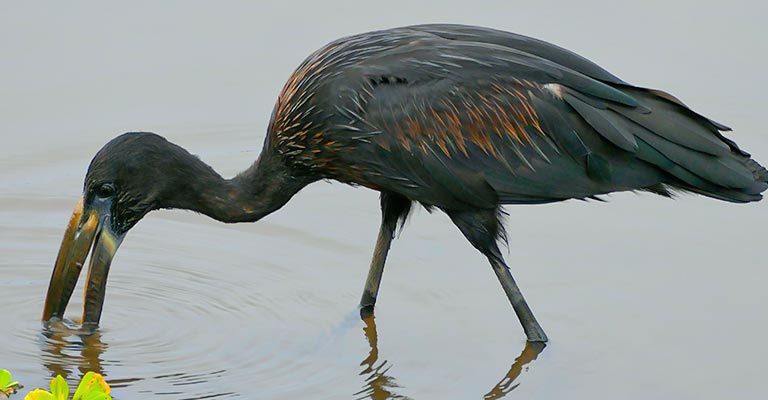
- The African openbill, scientifically known as Anastomus lamelligerus, is a species of bird found in sub-Saharan Africa.
- Its distinguishing feature is its uniquely shaped bill, characterized by a gap or notch near the tip, which gives it a distinctive “open” appearance.
- African openbills typically inhabit wetland habitats such as marshes, swamps, and floodplains, where they forage for aquatic invertebrates, particularly snails, using their specialized bill.
- These birds have predominantly dark plumage, often appearing black or dark brown, with subtle variations in shading and occasional iridescence.
- African openbills are medium-sized waterfowl with a body length ranging from 60 to 75 centimeters (24 to 30 inches).
A. oscitant (Asian Openbill)
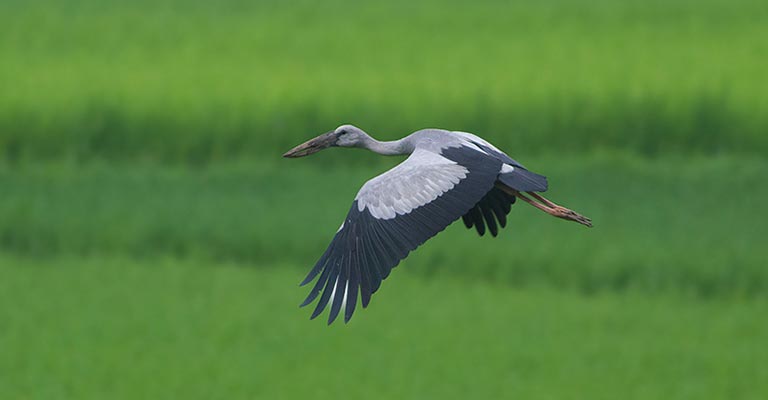
- The Asian openbill, scientifically known as Anastomus oscitans, is a species of bird found in South and Southeast Asia.
- Like its African counterpart, the Asian openbill is characterized by its distinctive bill structure, with a gap or notch near the tip.
- Asian openbills share similar habitat preferences with African openbills, favoring wetland habitats such as marshes, swamps, and rice paddies.
- They also feed on aquatic invertebrates, particularly snails, using their specialized bill to extract prey from muddy substrates.
- Asian openbills exhibit a similar plumage pattern to African openbills, with predominantly dark coloring and occasional iridescence.
Both A. lamelligerus (African openbill) and A. oscitans (Asian openbill) are closely related species within the Anastomus, sharing similar physical characteristics, behaviors, and ecological roles as specialized feeders in wetland environments.
Hunting Habit of Anastomus
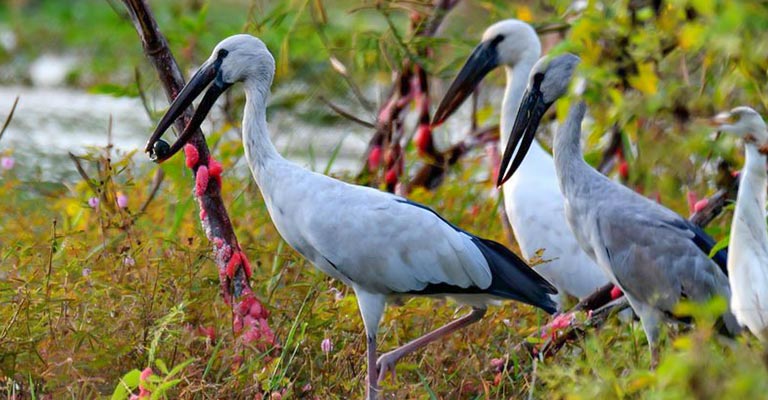
Anastomus birds, including the African openbill (Anastomus lamelligerus) and the Asian openbill (Anastomus oscitans), exhibit specialized hunting habits adapted to their diet of aquatic invertebrates, particularly snails.
These birds are primarily known for their unique bill structure, featuring a gap or notch near the tip, which aids in capturing and extracting prey from muddy substrates.
When hunting, Anastomus birds typically wade through shallow water, probing the mud and vegetation with their bills in an organized manner.
They use their keen sense of touch to detect and capture snails and other tiny aquatic organisms hiding beneath the surface.
Their hunting behavior is deliberate and precise, often characterized by slow movements and occasional pauses to consume captured prey.
This specialized feeding strategy allows Anastomus birds to efficiently forage for food in their preferred wetland habitats, contributing to their success as adept hunters in aquatic ecosystems.
Anastomus Life History
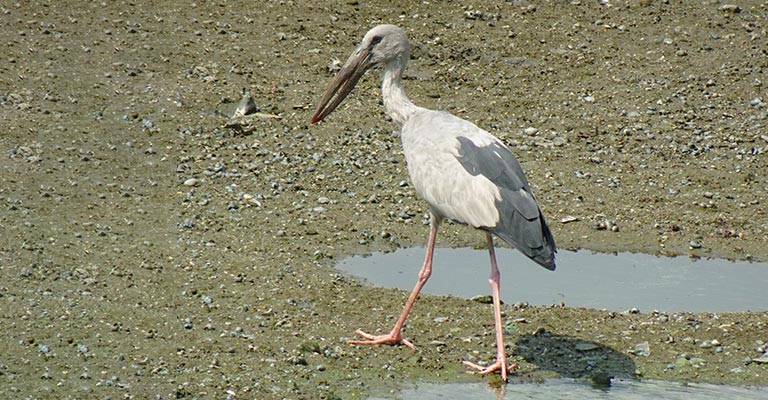
Anastomus birds, commonly known as openbills, possess a fascinating life history intricately tied to their ecological niche as specialized feeders in wetland habitats.
From their unique feeding adaptations to their breeding behaviors and conservation challenges, understanding the life history of Anastomus birds provides insight into their importance within ecosystems and the efforts needed to conserve them.
Food
Anastomus birds primarily feed on aquatic invertebrates, with a particular preference for snails. Their specialized bill, featuring a gap or notch near the tip, allows them to extract prey from muddy substrates efficiently.
In addition to snails, they also consume a variety of other tiny aquatic organisms, such as insects, crustaceans, and amphibians.
Habitat
These birds are predominantly found in wetland habitats, including marshes, swamps, flooded plains, and rice paddies.
These environments provide abundant food sources and suitable nesting sites for Anastomus birds, making them well-adapted to life in aquatic ecosystems.
Range Map

The range of Anastomus birds varies depending on the species. The African openbill (Anastomus lamelligerus) is native to sub-Saharan Africa, while the Asian openbill (Anastomus oscitans) is found in South and Southeast Asia.
Range maps illustrate the distribution of these species within their respective geographic regions.
Breeding
Breeding among Anastomus birds typically occurs during the wet season when water levels are high, and food resources are plentiful. They construct simple nests of twigs and vegetation in trees or reed beds near water bodies.
Mated pairs engage in courtship displays and share incubation duties until the eggs hatch. Chicks are precocial, meaning they are born with open eyes and can leave the nest shortly after hatching.
Diseases and Treatment
Anastomus birds may be susceptible to various diseases, including avian influenza and avian botulism, which can impact their populations.
Treatment often involves veterinary care and monitoring of wild populations to prevent the spread of disease. Additionally, habitat conservation measures can help reduce stressors contributing to disease susceptibility.
Conservation
Conservation efforts for Anastomus birds focus on preserving their wetland habitats, addressing threats such as habitat loss, pollution, and hunting pressure.
Protected areas and wetland management initiatives play a crucial role in safeguarding these birds and the ecosystems they inhabit.
Public awareness campaigns and research programs also contribute to conservation efforts to ensure the long-term survival of Anastomus species.
The life history of Anastomus birds is characterized by their specialized feeding habits, reliance on wetland habitats, breeding behaviors, and conservation challenges.
Understanding and addressing these aspects are essential for conserving these unique avian species and their ecosystems.
Nesting Destails of Anastomus
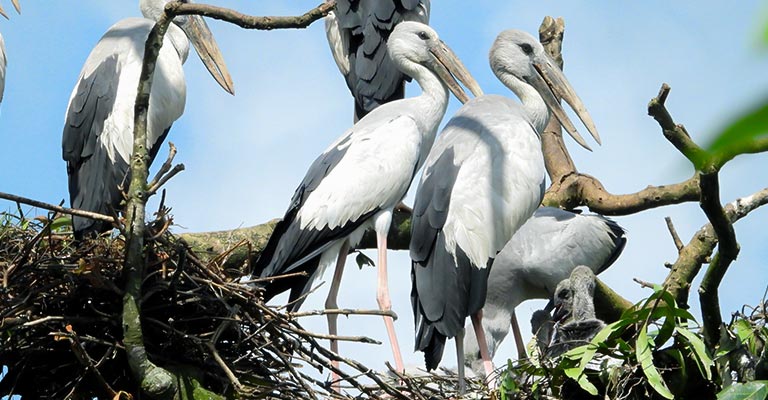
Anastomus birds typically lay clutches of 2-4 pale bluish or greenish eggs with dark spots or blotches.
African and Asian openbills share similar nesting habits, constructing simple nests made of twigs and vegetation in trees or reed beds near water bodies.
Incubation periods last around 25-30 days, with both parents sharing duties. After hatching, nestlings remain in the nest for approximately 4-5 weeks before fledging. Each breeding season usually results in one brood per pair.
These nesting details highlight the species’ adaptation to wetland environments and their commitment to parental care during the critical early stages of offspring development.
| Nesting Details | African Openbill (A. lamelligerus) | Asian Openbill (A. oscitans) |
| Clutch Size | 2-4 eggs | 2-4 eggs |
| Number of Broods | Usually 1 per breeding season | Usually 1 per breeding season |
| Egg Length | Approximately 6.5-7.5 cm (2.5-3 inches) | Approximately 6.5-7.5 cm (2.5-3 inches) |
| Egg Width | Approximately 3.5-4.0 cm (1.5-1.75 inches) | Approximately 3.5-4.0 cm (1.5-1.75 inches) |
| Incubation Period | Around 25-30 days | Around 25-30 days |
| Nestling Period | Approximately 4-5 weeks | Approximately 4-5 weeks |
| Egg Description | Pale bluish or greenish with dark spots or blotches | Pale bluish or greenish with dark spots or scars |
10 Behavioral Habits of Anastomus
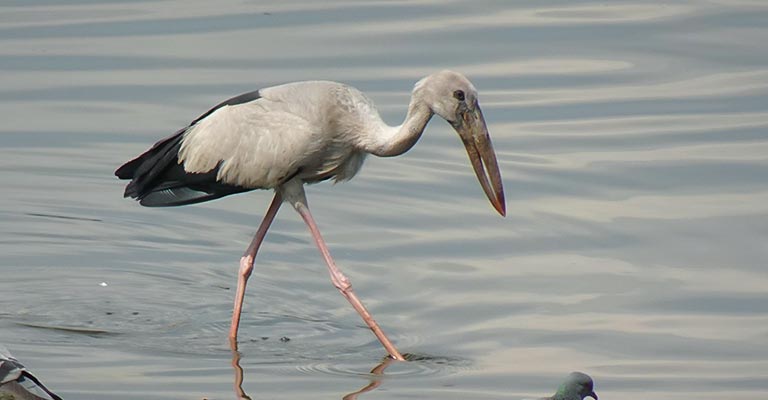
Anastomus birds, commonly known as openbills, exhibit diverse behavioral habits intricately linked to their survival in wetland habitats.
From foraging techniques to social interactions, understanding these behavioral traits provides insight into the adaptations of these fascinating avian species.
Specialized Foraging
Anastomus birds employ a unique foraging technique, utilizing their specialized bills to probe muddy substrates and extract prey such as snails and aquatic invertebrates.
Their methodical approach allows them to locate and capture food in their wetland habitats efficiently.
Social Foraging
While often observed foraging individually, Anastomus birds may also engage in social foraging, forming small groups to exploit food resources more effectively.
Cooperative behavior among group members enhances their foraging success, particularly in areas with abundant prey.
Territorial Behavior
During breeding, Anastomus birds may exhibit territorial behavior, defending nesting sites and foraging territories from intruders. Vocalizations and displays are commonly used to assert dominance and establish boundaries.
Courtship Displays
Mated pairs engage in elaborate courtship displays characterized by vocalizations, aerial acrobatics, and ritualized behaviors. These displays strengthen pair bonds and facilitate mate selection.
Nesting Site Selection
Anastomus birds carefully select nesting sites in trees or reed beds near water bodies, where they construct simple nests using twigs and vegetation.
Nest site fidelity is common among breeding pairs, with individuals returning to the same nesting site year after year.
Parental Care
Both parents participate in incubating the eggs and caring for the young hatchlings. They diligently tend to the nest, providing warmth and protection, and regurgitate food to feed the nestlings during the early stages of development.
Vocalizations
Anastomus birds produce a variety of vocalizations for communication, including soft calls during social interactions, alarm calls to warn of potential threats, and courtship calls during breeding displays.
Migration
Some populations of Anastomus birds may undertake seasonal migrations in response to changing environmental conditions, particularly in regions with fluctuating water levels or food availability.
Roosting Behavior
At dusk, Anastomus birds gather in communal roosting sites, resting and socializing before settling down for the night. Roosting sites may vary depending on habitat availability and environmental factors.
Agonistic Interactions
Competition for food and nesting sites can lead to agonistic interactions among Anastomus birds, including displays of aggression like bill-fencing and wing-fluttering.
These interactions help establish dominance hierarchies within populations.
Overall, the behavioral habits of Anastomus birds reflect their adaptability to wetland environments and the complex social dynamics that contribute to their survival and reproduction.
Wrapping Up
In conclusion, the behavioral habits of Anastomus birds exemplify their remarkable adaptability to wetland ecosystems.
From specialized foraging techniques to intricate social interactions, these avian species demonstrate a complex array of behaviors essential for survival and reproduction.
Through cooperative foraging, territorial defense, and meticulous parental care, Anastomus birds navigate the challenges of their habitat while contributing to the ecological balance of wetland environments.
Understanding and appreciating these behavioral adaptations enriches our knowledge of avian biology and underscores the importance of conservation efforts to safeguard these unique species and their habitats for future generations.